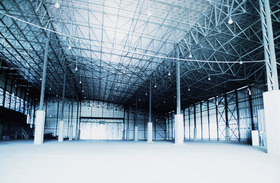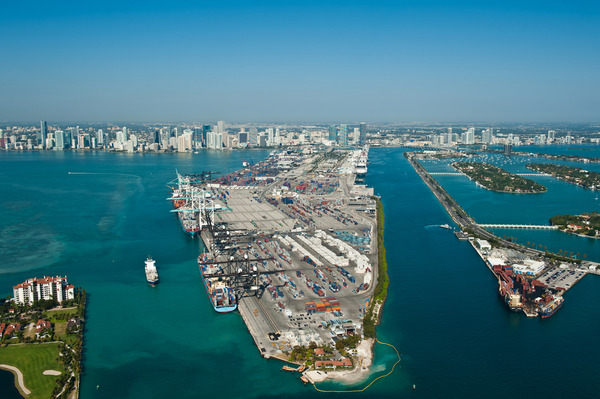The WPJ
THE WORLD PROPERTY JOURNALReal Estate Facts Not Fiction
Commercial Real Estate News

U.S. Industrial Real Estate Market Enjoying a Resurgence in Late 2012
Commercial News » North America Commercial News Edition | By Hortense Leon | February 20, 2013 9:15 AM ET
 The industrial real estate market is making a comeback. Net demand for warehouse space was 40.8 million square feet in fourth quarter 2012, making it the second strongest quarter since record-keeping began in 1993 at Cassidy Turley, a commercial real estate company with offices around the US.
The industrial real estate market is making a comeback. Net demand for warehouse space was 40.8 million square feet in fourth quarter 2012, making it the second strongest quarter since record-keeping began in 1993 at Cassidy Turley, a commercial real estate company with offices around the US.Industrial vacancies are tightening quickly, according to a report by Cassidy Turley. In the fourth quarter, vacancies declined by 20 basis points from the previous quarter to 8.9%. The national industrial vacancy rate was at its lowest point in three years in the fourth quarter of 2012. For certain product, such as big box distribution centers, the vacancy rate was below 4% in some locations, according to Cassidy Turley. With vacancies quickly eroding, it won't be long before rents escalate, according to the report.
The strongest demand for industrial real estate was in the Midwest and South, regions that accounted for 75% of the absorption in the fourth quarter, according to the Cassidy Turley report.
One of the biggest success stories over the last six to eight months has been the resurgence of the industrial real estate market in Indianapolis, where the vacancy rate was at an historical low for multi-tenant space, 3.3%, in fourth quarter 2012, according to Jason Tolliver, vice president of research at Cassidy Turley in Indianapolis.
About 3.2 million square feet of spec building is going on right now in the Indianapolis metro, says Tolliver, "a positive harbinger for the market, especially compared to four or five years ago." The area is centrally located and has a vast network of interstate highways, so lots of shipping is done by truck and through Indianapolis' international airport, says Tolliver. Indianapolis has the second largest FedEx hub, after Memphis, in the country, he says. In general, the Midwest is doing well, says Tolliver, partially because of the resurrection of manufacturing, and the rebound of the housing market.
The south is also benefitting from the recovery in the economy. "There is no question that the industrial market is active, especially in the Airport West and Medley markets," which are the most desirable submarkets in Miami and are the closest to Miami International Airport, says Michael Silver, first vice president at CBRE in Miami. "The vacancy factor dropped from 8% to 6% in the second half of last year and rental rates have climbed, depending on location and the size of the building, by 10% to 20% and sales prices have climbed as well," he says, noting that he is only talking about the more modern submarkets, like Airport West.
In Airport West, rental rates were about $7.50 to $8 per square foot gross in the first half of 2012, but in fourth quarter 2012 and today, the average rental rate is $8.50 to $9 per square foot gross," says Silver.
Also in the Airport West market, sales prices per square foot for industrial buildings were in the $80 per square foot range in 2011 and the first half of 2012, but now range from $90 to $110 per square foot, says Silver.
Currently, in Miami, there is about 1.2 million square feet of industrial real estate construction in Miami-Dade County says Silver, all in the Airport West and Medley markets. "This is the first time we are seeing spec building in Miami since mid-2007," he says.
Silver says that one reason for all the spec building in Miami today is that there is a shortage of certain-sized spaces. Also, he says, that there's been a 're-shoring' of jobs as companies are finding that labor costs in low-cost countries, like India and China, are growing. Manufacturers are bringing jobs back to the US, says Silver.
Miami-Dade, as a global city, benefits from the Port of Miami and Miami International Airport, says Silver. When the expansion of the Panama Canal is completed in 2015, that will benefit Miami, he says. The dredging project at the Port of Miami, which is currently in the works, will help accommodate the larger ships, says Silver.
The big question, says Silver, is how much of the merchandise that comes in on Post-Panamax ships (larger ships that will be able to pass through the Panama Canal only after the expansion is complete) will stay in the area and how much will be shipped north. "But enough product will stay here, that there will be a need for several million square feet of new industrial space," he says.
Sign Up Free | The WPJ Weekly Newsletter
Relevant real estate news.
Actionable market intelligence.
Right to your inbox every week.
Real Estate Listings Showcase
Related News Stories
Commercial Real Estate Headlines
- 2025 Prediction: U.S. Commercial Investment Recovery Expected to Gain Traction
- Holiday Retail Sales for 2024 to Hit Record $1 Trillion
- Tech, AI Industries Drive Largest Share of Office Leasing Activity in U.S.
- Commercial Real Estate Lending in U.S. Enjoys Strong Growth in Q3
- U.S. Multifamily Market Begins Recovery in Q3
- Commercial Investment in Japan Spikes 24 Percent Annually in Q3
- Despite Return-to-Office Mandates, U.S. Office Vacancies Continue to Rise
- PROPSIG Tech Startup Acquired by World Property Data
- U.S. Commercial Mortgage Debt Hits $4.7 Trillion in Q2 as Delinquencies Increase
- Hong Kong Class A Office Rents Continue to Downtick in Mid-Summer
- U.S. Office Landlords Tenant Concessions Decline for First Time in 4 Years
- U.S. Commercial Mortgage Originations Spike 27 Percent in Q2 Over Q1
- Phnom Penh's Commercial Office, Retail Markets Face Slowdowns in 2024
- Global Edge Data Center Market to Hit $300 Billion by 2026
- Commercial Property Transactions in Japan Dive 25 Percent Annually in Q2
- Delinquency Rates for U.S. Commercial Property Loans Downticks in Q2
- Megawarehouse Lease Deals in U.S. Increase in 2024
- Office Tenants' Flight to Quality Buildings Increases in 2024
- Commercial Lending in Japan Upticks 6 Percent Annually in Q1
- AI Driving Significant Global Data Center Growth in 2024
- Total U.S. Commercial Mortgage Debt Rises to $4.7 Trillion in Q1
- U.S. Commercial Mortgage Delinquencies Rise in Early 2024
- Asia Pacific Office Sector to Further Reprice Throughout 2024
- U.S. Retail Foot Traffic to Surpass Pre-Pandemic Levels by 2025
- Commercial Real Estate Lending in U.S. Slowed in First Quarter
- Japan Commercial Property Investment Volume Jumps 7 Percent in Q1
- Asia Pacific Commercial Property Investment Leads the World, Spikes 13 Percent
- Driven by High Rates, U.S. Commercial Lending Imploded 47 Percent in 2023
- After Two Year Slump, Prime Multifamily Metrics Uptick in U.S.
- Commercial Co-Broker Commissions Not Affected by NAR-DOJ Settlement, Yet
- U.S. Office Buildings with Upscale Tenant Amenities Still Enjoy Premium Rents in 2024
- U.S. Commercial, Multifamily Mortgage Delinquency Rates Uptick in Q4
- U.S. Commercial Mortgage Debt Continued to Rise in 2023, Hits $4.7 Trillion
- Nonresidential Construction Spending in the U.S. Falls Sharply in January
- U.S. Multifamily Construction Starts to Decline in 2024
- Commercial Mortgage Lending in U.S. Shows Signs of Stabilization in Late 2023
- Architecture Billings Decline in December as Soft Business Conditions Persist
- Government Sector Claimed Largest Portion of 100 Biggest U.S. Office Leases Signed in 2023
- U.S. Commercial, Multifamily Borrowing Dives 25 Percent Annually in Late 2023
- Record High Multifamily Construction Deliveries Drive Vacancy Rates Higher
Reader Poll
Marketplace Links
This website uses cookies to improve user experience. By using our website you consent in accordance with our Cookie Policy. Read More






